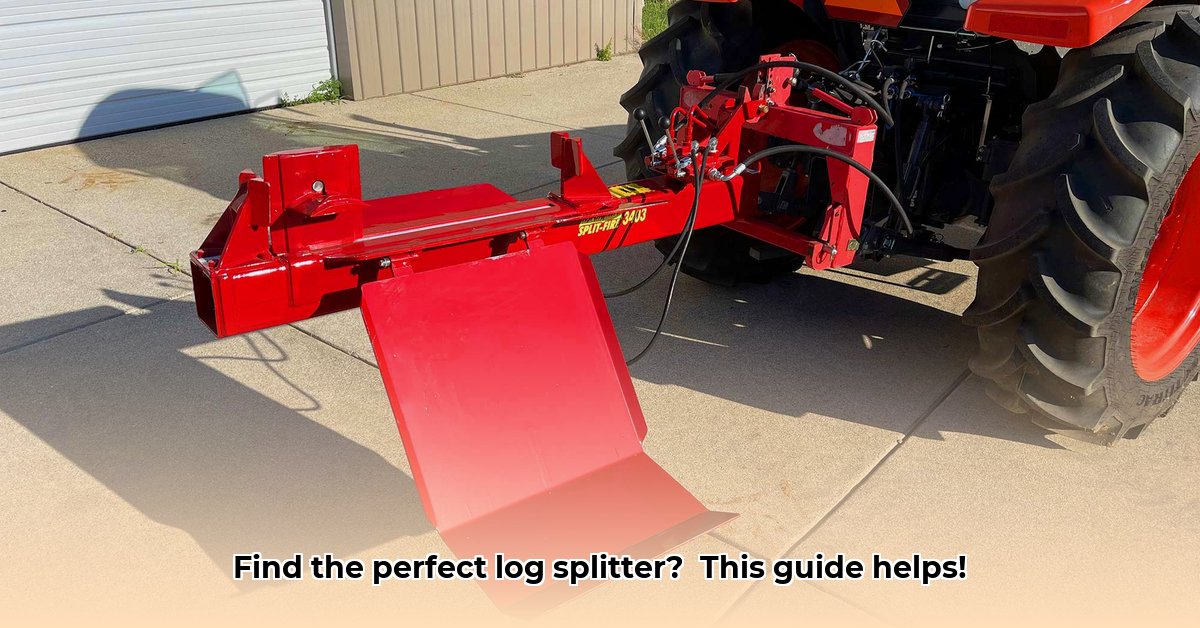
Forget backbreaking manual labor! Transform firewood preparation with a tractor-mounted log splitter. This comprehensive guide helps you choose the perfect model, guiding you through the differences between 3-point hitch and PTO-driven systems. We'll cover safe attachment and operation, troubleshooting, and essential factors for selecting the right splitter for your needs. Whether you're a seasoned pro or a first-timer, this guide ensures efficient and safe wood splitting. For more detailed information on PTO-driven splitters, check out this helpful resource.
Tractor Mount Log Splitters: 3-Point Hitch vs. PTO-Driven
Selecting the right tractor-mounted log splitter significantly streamlines firewood preparation. Understanding the differences between 3-point hitch and PTO (Power Take-Off) driven models is crucial. A 3-point hitch splitter uses your tractor's hydraulic system directly for power, offering simplicity and efficiency. Conversely, a PTO-driven splitter uses a dedicated hydraulic pump powered by the tractor's PTO shaft, providing more independent operation but increased complexity and cost. Think of it like this: a 3-point hitch is like using a hose directly connected to your home's main water line; a PTO-driven splitter is like using a separate well pump with its own power source. Which option best meets your needs?
Detailed Comparison: Specifications and Features
This table compares hypothetical models. Actual specifications vary by manufacturer and model. Prices are estimates and subject to change.
| Feature | Model A (3-Point) | Model B (3-Point) | Model C (PTO) | Model D (PTO) |
|---|---|---|---|---|
| Manufacturer | Acme | Beta | Gamma | Delta |
| Splitting Force (Tons) | 25 | 30 | 20 | 35 |
| Cycle Time (seconds) | 15 | 12 | 18 | 10 |
| Max. Log Length (inches) | 36 | 48 | 30 | 54 |
| Hydraulic Requirements | 10 GPM/2500 PSI | 15 GPM/3000 PSI | N/A (PTO-driven) | N/A (PTO-driven) |
| Weight (lbs) | 750 | 900 | 800 | 1200 |
| Approximate Price (USD) | $3,500 | $4,200 | $4,000 | $5,000 |
(Note: "N/A" indicates that the specification is not applicable to PTO-driven models due to their independent hydraulic systems.)
Step-by-Step: Safe Attachment and Operation
Safety is paramount. Always consult your splitter's manual before operation. These are general guidelines.
3-Point Hitch Splitter Attachment and Operation:
- Preparation: Turn off the tractor and engage the parking brake.
- Lifting the Hitch: Raise the tractor's 3-point hitch to its highest point.
- Connecting the Splitter: Align the splitter's hitch pins with the tractor's hitch points and secure firmly.
- Lowering the Splitter: Slowly lower the splitter using the tractor's control lever. Avoid sudden movements.
- Hydraulic Connections: Securely connect the splitter's hydraulic lines to the tractor's quick-couplers.
- Starting the Tractor: Start the tractor and monitor for leaks or unusual noises.
PTO-Driven Splitter Attachment and Operation:
- Engage the PTO: With the tractor OFF, engage the tractor's PTO shaft to the correct setting.
- Connecting the PTO Shaft: Carefully connect the splitter's PTO shaft to the tractor's PTO shaft; secure the connection per manufacturer instructions.
- Hydraulic Connections: Connect the splitter’s hydraulic lines.
- Starting the Tractor: Start the tractor and carefully check for leaks.
(Illustrations and videos would enhance these instructions in the published article.)
Troubleshooting Common Problems
Addressing issues promptly keeps your splitter running smoothly.
- Sluggish Splitting: Check hydraulic fluid levels, ensure adequate hydraulic pressure, and inspect hoses for leaks.
- Non-Operational Splitter: Double-check all hydraulic connections, fuses, and circuit breakers. Ensure the PTO is fully engaged.
- Hydraulic Leaks: Inspect all hydraulic lines, connections, and fittings for damage or loose connections.
Buyer's Guide: Choosing the Right Log Splitter
Consider these factors when selecting a log splitter:
- Tractor Compatibility: Your tractor's horsepower (HP) and hydraulic flow rate (GPM) must meet the splitter's requirements.
- Firewood Volume: Estimate your annual firewood needs to determine the necessary splitting force and speed.
- Budget: Account for purchase price, maintenance, and potential repairs.
- Safety Features: Prioritize safety features like wedge guards and automatic shutoff mechanisms.
Selecting a Log Splitter Based on Tractor Horsepower and GPM
Choosing between a three-point hitch and PTO-driven splitter depends heavily on your tractor's capabilities and your specific needs. Insufficient GPM will result in slow cycle times, while inadequate pressure can prevent splitting even small logs.
| Splitter Model | Splitting Force (Tons) | Cycle Time (sec) | Log Length (in) | GPM Required | Pressure (psi) | Manufacturer | Price (USD) |
|---|---|---|---|---|---|---|---|
| Example Splitter A | 25 | 15 | 36 | 10 | 2500 | Brand X | 5000 |
| Example Splitter B | 15 | 20 | 24 | 5 | 2000 | Brand Y | 3500 |
| Example Splitter C | 30 | 12 | 48 | 15 | 3000 | Brand Z | 7000 |
(Note: These are example values. Actual specifications vary by manufacturer and model.)
Safety Precautions: Prioritize Safety
- Always receive proper training before operating a log splitter.
- Wear appropriate safety gear: eye protection, gloves, and sturdy footwear.
- Keep children and pets away from the operating area.
- Inspect the splitter before each use.
- Never reach into the splitting chamber while the splitter is operating.
(This guide provides general information; consult your equipment's manual for specific instructions and safety precautions.)